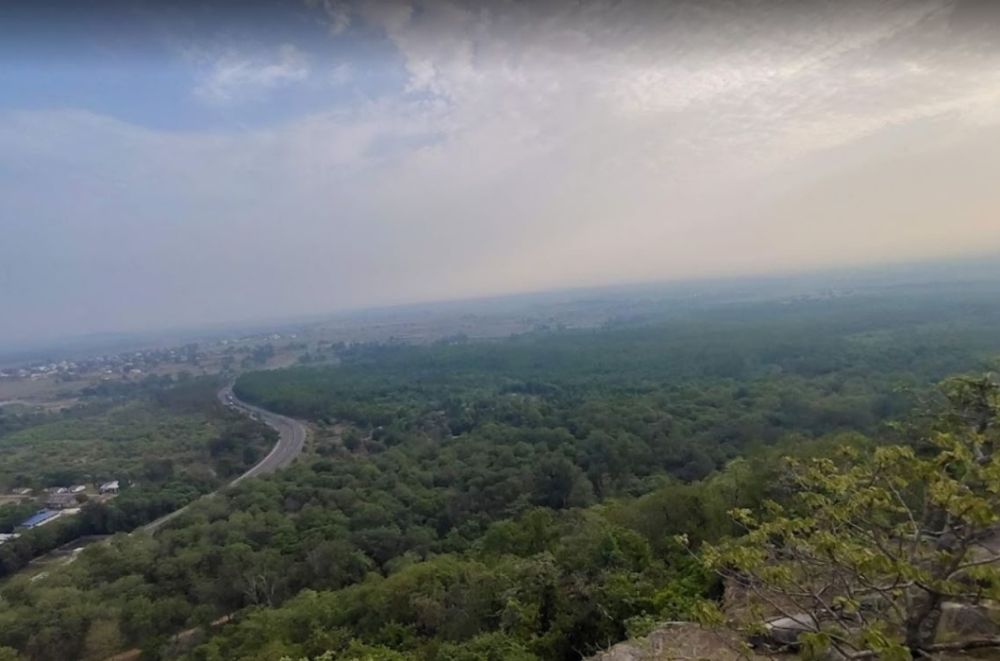Hazaribagh, situated in the Indian state of Jharkhand, experiences a subtropical climate with distinct seasons. Summers, from March to June, are hot and humid with temperatures often exceeding 40°C (104°F). Monsoon season arrives in July and lasts until September, bringing heavy rainfall and occasional thunderstorms. Winters, from November to February, are relatively cooler with temperatures ranging from 10°C to 25°C (50°F to 77°F). Overall, Hazaribagh’s weather offers a varied experience throughout the year, with each season bringing its own charm and challenges.

Hazaribagh Weather 10 days
| Day | Max Temp (°C) | Min Temp (°C) | Weather Condition |
|---|---|---|---|
| Monday | 35 | 25 | Sunny |
| Tuesday | 34 | 24 | Partly Cloudy |
| Wednesday | 33 | 23 | Scattered Showers |
| Thursday | 32 | 22 | Thunderstorms |
| Friday | 31 | 21 | Heavy Rain |
| Saturday | 30 | 22 | Mostly Cloudy |
| Sunday | 33 | 24 | Partly Sunny |
| Monday | 34 | 25 | Sunny |
| Tuesday | 35 | 25 | Partly Cloudy |
| Wednesday | 36 | 26 | Clear Skies |
A Season-by-Season Guide to Hazaribagh Weather
Here’s a season-by-season guide to the weather in Hazaribagh:
- Summer (March to June):
- Characteristics: Summers in Hazaribagh are hot and humid, with temperatures often soaring above 40°C (104°F).
- Experience: This season is marked by scorching heat and high humidity levels, making outdoor activities uncomfortable. It’s advisable to stay indoors during the hottest part of the day and drink plenty of fluids to stay hydrated.
2. Monsoon (July to September):
- Characteristics: Monsoon season brings relief from the heat, with heavy rainfall and occasional thunderstorms.
- Experience: The region experiences a significant amount of rainfall during the monsoon, rejuvenating the landscape and providing respite from the intense summer heat. However, the heavy downpours can lead to waterlogging and travel disruptions.
3. Autumn (October to November):
- Characteristics: Autumn in Hazaribagh is characterized by mild temperatures and relatively dry weather.
- Experience: This season offers pleasant weather, with cooler temperatures and clear skies. It’s an ideal time for outdoor activities such as trekking and sightseeing, as the weather is comfortable and the landscape is lush green.
4. Winter (December to February):
- Characteristics: Winters in Hazaribagh are cool and dry, with temperatures Hazaribagh Weather ranging from 5°C to 20°C (41°F to 68°F).
- Experience: The winter season brings cooler temperatures and dry weather, making it a pleasant time to visit Hazaribagh. It’s a great time for outdoor activities, bonfires, and enjoying the natural beauty of the region without the discomfort of extreme heat or rainfall.
Geographical Factors Influencing Hazaribagh Weather
Several geographical factors influence the weather patterns experienced in Hazaribagh. Here’s an overview of the key factors:
- Topography: Hazaribagh is located in the Chota Nagpur Plateau region, characterized by undulating terrain, hills, and valleys. The topography plays a significant role in influencing local weather patterns, including temperature variations and precipitation distribution.
- Altitude: While not at high altitude, Hazaribagh’s elevation contributes to its climate. The region experiences cooler temperatures compared to lower-lying areas, particularly during the winter months.
- Proximity to Forests: Hazaribagh is surrounded by dense forests, contributing to its microclimate. Forested areas influence temperature regulation, humidity levels, and precipitation patterns, creating a more moderate climate within the region.
- Monsoon Winds: Hazaribagh experiences the impact of the southwest monsoon, which brings heavy rainfall to the region during the monsoon season (July to September). The presence of forests and hills can influence the distribution of rainfall, leading to localized variations in precipitation.
- River Systems: Rivers such as the Damodar River and its tributaries flow through the Hazaribagh region, affecting local weather conditions. River systems can moderate temperatures, influence humidity levels, and contribute to the formation of fog and mist in certain areas.
- Urbanization: Urbanization and development in Hazaribagh can influence local weather patterns. Urban heat island effects may lead to slightly higher temperatures in urban areas compared to rural surroundings. Land use changes can also affect temperature and precipitation distribution.
- Wind Patterns: Hazaribagh’s location within the Chota Nagpur Plateau region influences wind patterns. Prevailing winds from the northeast and southeast directions can impact temperature, humidity, and rainfall distribution in the area.
- Latitude: Hazaribagh’s location near the Tropic of Cancer influences its climate. The region experiences a subtropical climate with distinct seasons, including hot summers, monsoon rains, and cool winters.
Climate Change in Hazaribagh
Climate change poses significant challenges to Hazaribagh, affecting its environment, economy, and residents. Here are some key aspects of climate change impacting Hazaribagh:
- Temperature Increase: Hazaribagh is experiencing a rise in average temperatures, leading to hotter summers and warmer winters. This increase in temperature can exacerbate heat-related illnesses and affect agricultural productivity.
- Altered Rainfall Patterns: Climate change is disrupting traditional rainfall patterns in Hazaribagh. While the region relies heavily on the monsoon season for water supply, changes in precipitation patterns can lead to erratic rainfall, droughts, and floods, affecting agriculture and water resources.
- Water Scarcity: Changes in rainfall patterns and increasing temperatures contribute to water scarcity issues in Hazaribagh. Diminished water availability affects agriculture, sanitation, and daily life for residents, particularly during periods of water stress.
- Impact on Agriculture: Hazaribagh’s economy is largely dependent on agriculture, which is vulnerable to Hazaribagh Weather the impacts of climate change. Erratic rainfall, temperature extremes, and pest infestations can damage crops, leading to reduced yields and income losses for farmers.
- Loss of Biodiversity: Climate change threatens Hazaribagh’s rich biodiversity, including its forests, wildlife, and ecosystems. Changes in temperature and rainfall patterns can disrupt habitats, leading to species loss and affecting ecosystem services.
- Health Risks: Climate change poses health risks to the residents of Hazaribagh, including heat-related illnesses, vector-borne diseases, and respiratory ailments. Extreme weather events such as heatwaves and floods can lead to injuries, displacement, and stress on healthcare systems.
- Infrastructure Vulnerability: Hazaribagh’s infrastructure is vulnerable to the impacts of climate change, including increased flooding, landslides, and erosion. Poorly constructed buildings, roads, and drainage systems are at risk of damage during extreme weather events.
- Adaptation Efforts: Hazaribagh is implementing various adaptation strategies to cope with the impacts of climate change. These include water conservation measures, crop diversification, disaster Hazaribagh Weather preparedness initiatives, and community resilience-building programs.
- Mitigation Measures: Efforts to mitigate climate change in Hazaribagh focus on reducing greenhouse gas emissions and promoting sustainable development practices. These measures include afforestation projects, renewable energy initiatives, and promoting energy efficiency.
- Community Engagement: Engaging local communities in climate change mitigation and adaptation efforts is essential for building resilience and fostering sustainable development in Hazaribagh. Community-based initiatives, education, and awareness-raising campaigns play a crucial role in mobilizing action at the grassroots level.
Interesting Facts About Hazaribagh
Certainly! Here are some interesting facts about Hazaribagh:
- Tiger Reserve: Hazaribagh is home to the Hazaribagh Wildlife Sanctuary, which was established in 1954 and later declared a tiger reserve in 1976. It covers an area of approximately 184 square kilometers and is known for its diverse flora and fauna, including tigers, leopards, sloth bears, and various species of deer and birds.
- Historical Significance: Hazaribagh has a rich historical heritage, with archaeological evidence indicating human habitation dating back to ancient times. The region has been influenced by various dynasties and rulers, including the Mauryas, Guptas, and Mughals.
- Natural Beauty: Hazaribagh is renowned for its scenic beauty, with lush green forests, rolling hills, and sparkling lakes dotting the landscape. The region’s picturesque surroundings make it a popular destination for nature lovers, trekkers, and wildlife enthusiasts.
- Mica Mines: Hazaribagh is known for its abundant deposits of mica, a mineral widely used in industries such as electronics, cosmetics, and construction. The region has a long history of mica mining, although concerns Hazaribagh Weather about environmental sustainability and labor rights have arisen in recent years.
- Cultural Diversity: Hazaribagh is home to a diverse population comprising various ethnicities, languages, and cultures. The region’s cultural heritage is reflected in its festivals, music, dance, and traditional crafts, making it a vibrant and dynamic place to explore.
- Waterfalls: Hazaribagh is blessed with several scenic waterfalls, including the Jonha Falls and Hundru Falls, which attract tourists and locals alike with their breathtaking beauty. These cascading waterfalls offer opportunities for relaxation, picnicking, and photography amidst nature’s splendor.
- Adventure Activities: Hazaribagh offers a range of adventure activities for thrill-seekers, including trekking, rock climbing, and boating. The region’s rugged terrain and natural landscapes provide the perfect backdrop for outdoor adventures and adrenaline-fueled experiences.
- Cuisine: Hazaribagh boasts a rich culinary tradition, with local delicacies influenced by the region’s cultural diversity and Hazaribagh Weather natural resources. Staple foods include rice, lentils, vegetables, and meat dishes, often flavored with aromatic spices and herbs.
- Handicrafts: Hazaribagh is known for its traditional handicrafts, including pottery, basket weaving, and wood carving. Local artisans showcase their craftsmanship through intricately designed artifacts and souvenirs, reflecting the region’s cultural heritage and artistic prowess.
- Silk Production: Hazaribagh is renowned for its silk production, particularly tussar silk, which is derived from the cocoons of silkworms native to the region. The silk industry plays a significant role in the local economy and cultural identity of Hazaribagh.
Tips for Traveling in Hazaribagh
Traveling to Hazaribagh offers a unique blend of natural beauty, cultural heritage, and adventure. Here are some tips to enhance your experience while visiting Hazaribagh:
- Research Before You Go: Familiarize yourself with Hazaribagh’s attractions, weather conditions, and local customs before your trip to make the most of your time there.
- Pack Appropriately: Depending on the season of your visit, pack lightweight and breathable clothing for summers and warm layers for winters. Don’t forget essentials like sunscreen, insect repellent, and sturdy footwear for outdoor activities.
- Stay Hydrated: Hazaribagh’s climate can be hot and humid, especially during the summer months. Carry a reusable water bottle and drink plenty of fluids to stay hydrated throughout the day.
- Respect Local Customs: Hazaribagh has a rich cultural heritage, so respect local customs and traditions. Dress modestly when visiting religious sites and seek permission before taking photographs of locals.
- Explore Nature: Hazaribagh is known for its natural beauty, including wildlife sanctuaries, Hazaribagh Weather waterfalls, and scenic landscapes. Take time to explore these natural attractions, go for hikes, and immerse yourself in the tranquility of nature.
- Adventure Activities: If you’re an adventure enthusiast, Hazaribagh offers a range of activities such as trekking, rock climbing, and boating. Engage in these activities under the guidance of experienced professionals to ensure safety.
- Try Local Cuisine: Don’t miss the opportunity to sample authentic local cuisine in Hazaribagh. Explore street food stalls, dine at local eateries, and savor traditional dishes like litti chokha, mutton curry, and pitha.
- Stay Safe: Hazaribagh is relatively safe for travelers, but it’s essential to take precautions, especially when venturing into remote areas or participating in adventure activities. Keep your valuables secure and be mindful of your surroundings at all times.
Conclusion
Hazaribagh offers a captivating journey through its natural wonders, cultural heritage, and adventurous spirit. By respecting local customs, embracing nature, and exploring the region’s diverse attractions, travelers can immerse themselves in the rich tapestry of Hazaribagh’s landscapes and traditions. Whether trekking through lush forests, savoring local cuisine, or engaging in adventure activities, Hazaribagh provides a unique and memorable experience for every traveler. As visitors depart, they carry with them not only memories of their time in this enchanting destination but also a deeper appreciation for its beauty, charm, and vibrant culture. Hazaribagh remains an inviting haven for those seeking adventure, discovery, and connection with the wonders of nature and the warmth of its people.
FAQs
During summer (March to June), Hazaribagh experiences hot and humid weather, with temperatures often exceeding 40°C (104°F).
The monsoon season in Hazaribagh usually occurs from July to September, bringing heavy rainfall and occasional thunderstorms.
Winter temperatures in Hazaribagh, from November to February, typically range from 5°C to 20°C (41°F to 68°F), with cool and pleasant weather.
Yes, Hazaribagh can experience extreme weather conditions, including heatwaves during summer and heavy rainfall during the monsoon season.




















